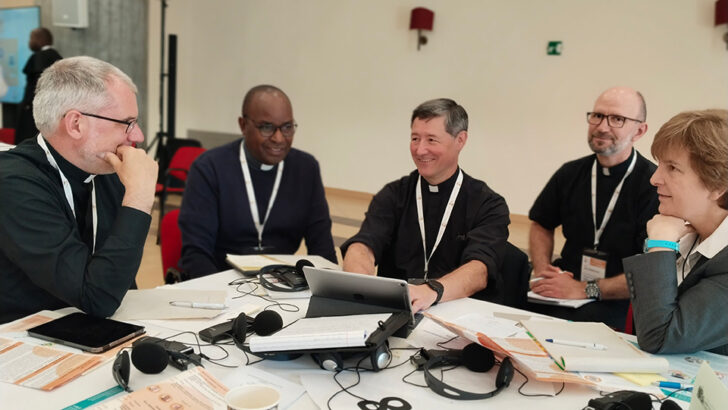The first report of the Synod on Synodality was published last month and makes for very interesting reading. It was the first of two sessions.
Of the 364 voting delegates who attended, 50 were women and they, with the lay men and others who attended, were able to vote on this report and on the 2024 report. While 1 woman for every 7 men was a very distinct under-representation, it was a very significant improvement on previous practice and the need for greater female involvement is stressed: “It is urgent to ensure that women can participate in decision-making processes and assume roles of responsibility in pastoral care and ministry. The Holy Father has significantly increased the number of women in positions of responsibility in the Roman Curia. This should also happen at other levels of Church life, in consecrated life and in the dioceses. Provision needs to be made in Canon Law accordingly.” Hopefully there will be more women as voting members in 2024.
It was a universal synod attended by, among others, 20 representatives of the Eastern Churches, including the Coptic Catholic Church, the Greek Melkite Catholic Church, the Maronite Church, the Armenian Catholic Church, and the Syro Malabar Church. Representative of each continent attended. Bishop Brendan Leahy and Bishop Alan McGuckian were there from Ireland with men deeply committed to the synodal process with all that it entails.
Divided
The 41-page report is divided into 3 major sections: The Face of the Synodal Church, All Disciples, All Missionaries, and Weaving Bonds, Building Communities. Within the three sections, a total of 20 areas of Church life are considered. The conclusions are reported under three headings: Convergences, Matters for Consideration and Proposals. It all makes for a very easily read document. It is all very focused and for the most part, very clear. It is work in progress.
The beginning the report says that “the Second Vatican Council was, in fact, like a seed sown in the field of the world and the Church. The soil in which it germinated and grew was the daily lives of believers, the experience of the Churches of every people and culture, the many testimonies of holiness, and the reflections of theologians. The Synod 2021-2024 continues to draw on the energy of that seed and to develop its potential.” It tells us that “The synodal path is, in fact, implementing what the Council taught about the Church as Mystery and People of God, called to holiness. It values the contribution all the baptised make, according to their respective vocations, in helping us to understand better and practice the Gospel. In this sense, it constitutes a true act of further reception of the Council, prolonging its inspiration and reinvigorating its prophetic force for today’s world.”
The focus, though, is on how we move forward on the journey, each of us seeking discernment on the journey through ‘authentic discipleship that develops the grace of Baptism’”
At the end, the report of the Assembly is described as a “small seed.” It concludes with a very real aspiration: “We carry in our hearts the desire, sustained by hope, that the climate of mutual listening and sincere dialogue that we experienced during the days of common work in Rome will radiate in our communities and throughout the world, at the service of the growth of the good seed of the Kingdom of God.”
It does not hesitate to name some of the major issues facing the Church in the world. The focus, though, is on how we move forward on the journey, each of us seeking discernment on the journey through “authentic discipleship that develops the grace of Baptism.”
The challenges are named: hearing and responding to those living in poverty of all kinds material and spiritual: “migrants and refugees; indigenous peoples, original and Afro-descendent peoples; those who suffer violence and abuse, in particular women; people struggling with addiction; minorities who are systematically denied a voice; abandoned elderly people; victims of racism, exploitation, and trafficking, especially minors; exploited workers; the economically excluded, and others living on the peripheries. The most vulnerable of the vulnerable, on whose behalf constant advocacy is needed, include the unborn and their mothers.” The Assembly condemns the corrupt political and economic systems that cause such problems.
Actions
Speaking clearly, the report says that action needed to address these matters, includes protecting the rights of those who are excluded and says that this may require public denunciation of injustices, whether perpetrated by societal structures or by individuals, corporations or governments, something many in the Church are already doing.
Even where further clarification is required, Jesus’ actions, assimilated in prayer and conversion of heart, show us the way forward”
It acknowledges that “matters of identity and sexuality, the end of life, complicated marital situations, and ethical issues related to artificial intelligence, are controversial not only in society, but also in the Church, because they raise new questions.” It says that “Sometimes the anthropological categories we have developed are not able to grasp the complexity of the elements emerging from experience or knowledge in the sciences and require greater precision and further study. It is important to take the time required for this reflection and to invest our best energies in it, without giving in to simplistic judgements that hurt individuals and the Body of the Church… Even where further clarification is required, Jesus’ actions, assimilated in prayer and conversion of heart, show us the way forward.” That thoughtful, gentle analysis is reflective of the whole report.
Acknowledging that “Transparency and a culture of accountability are of crucial importance for us to move forward in building a synodal Church,” it asks local churches to identify processes and structures that allow for a regular audit of how priests and deacons are carrying out roles of responsibility in the exercise of their ministry. It advocates structures and processes for regular review of the bishop’s performance, with reference to the style of his authority, the economic administration of the diocese’s assets and the functioning of participatory bodies, and safeguarding against all possible kinds of abuse. Such accountability of those in ministry will be welcome. It would enable the laity to understand just what is really involved in ministry and could lead to more focused, strategic development of the Church in a way which would enhance the mission.
Context
It states that “On a case-by-case basis, and in accordance with the context, the possibility should be considered of re-inserting priests who have left the ministry in pastoral services that recognise their formation and experience.” It is not clear from the document what is proposed by these words. Many of those who left the ministry are currently actively engaged in their local church communities. Could it mean more? Allowing such men who wish to return to ministry to do so?
It calls for the involvement of “men and women who have an apostolic disposition, distinguished not by their frequent presence in Church, but by a genuine evangelical witness in ordinary life in the various councils for the discernment and decision-making of a synodal missionary community.
What is clear is that everyone has a role to play. It says that we have a duty to participate in building up the common good and defending the dignity of life, drawing inspiration from the Church’s social doctrine and working together in various ways, through engagement in civil society organisations, trade unions, popular movements, grassroots associations, in the field of politics, and so forth. This is all part of the Church’s mission.
There is much in this report to give hope. It is but a step on the journey.


 Nuala O’Loan
Nuala O’Loan Priests work in an English-language small group April 30, 2024, with facilitator Sister Maria Cimperman, a Religious of the Sacred Heart of Jesus, as part of a meeting of parish priests from around the world gathered at Sacrofano, outside of Rome, to share their experiences and contribute to the ongoing synod on synodality. Photo: CNS/Courtesy of the Synod of Bishops
Priests work in an English-language small group April 30, 2024, with facilitator Sister Maria Cimperman, a Religious of the Sacred Heart of Jesus, as part of a meeting of parish priests from around the world gathered at Sacrofano, outside of Rome, to share their experiences and contribute to the ongoing synod on synodality. Photo: CNS/Courtesy of the Synod of Bishops
